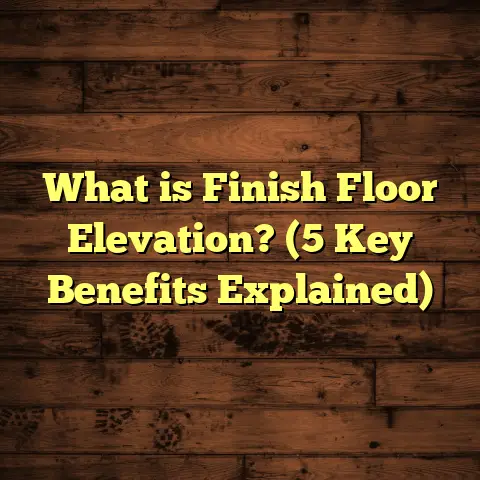What is a Hollow Floor? (5 Key Benefits for Your Building)
Have you ever walked into a building and felt like the floor beneath you was doing much more than just holding your weight? I certainly had that experience when I first encountered a hollow floor system on a commercial retrofit project. At first glance, it looked like any other floor—but once I learned about what lay beneath the surface, it completely changed how I think about flooring and building infrastructure.
What is a Hollow Floor?
A hollow floor, also called a raised floor or access floor, is a raised platform built above the structural slab of a building, creating a hidden empty space between the two. This space, typically ranging from 2 to 24 inches (around 50 mm to 600 mm) in height, serves as a functional void for running all sorts of building services—cabling, electrical wires, data lines, heating and cooling ducts, even plumbing pipes.
Unlike traditional flooring systems that sit directly on the concrete slab or wood subfloor, hollow floors rest on adjustable pedestals or supports. These pedestals hold up modular panels made from materials like steel, cementitious core, wood-core particleboard, or even composite materials. On top of these panels, the final flooring finish is installed—carpet tiles, vinyl sheets, laminate planks, or hardwood.
This clever design creates an easily accessible underfloor space that can be adapted and modified without heavy demolition. The modular nature of the panels means individual sections can be lifted and replaced quickly.
Why would someone choose a hollow floor instead of a traditional floor?
That was the question I asked myself when I first saw this system. After working with it extensively, I realized that hollow floors offer unique advantages:
- Flexibility: Easily reroute cables and pipes as needs change.
- Maintenance: Quick access for repairs without tearing up walls or ceilings.
- Airflow: Use the underfloor cavity for efficient heating and cooling distribution.
- Soundproofing: Add insulation in the void to reduce noise transmission.
- Sustainability: Modular panels can be reused or recycled.
Let me break down exactly how they work and why they are becoming popular in offices, data centers, hospitals, schools, and even some high-end residential projects.
Components of Hollow Floors
Understanding what goes into a hollow floor is crucial to appreciating its benefits:
Pedestals
Pedestals are vertical supports anchored to the concrete slab. They can be made from galvanized steel or aluminum and are height-adjustable to create a perfectly level floor surface even over uneven slabs.
Typical pedestal heights range from 2 inches (50 mm) up to 24 inches (600 mm) depending on how much space is needed for services. For most office applications, 4 to 8 inches (100-200 mm) is standard.
Panels
Panels sit on top of the pedestals and interlock to create the walking surface. Sizes commonly are 24″x24″ (610 mm x 610 mm), but custom sizes exist. Materials vary based on load requirements and budget:
- Steel panels: Heavy-duty and durable for industrial use.
- Cementitious core: Fire-resistant and strong.
- Wood-core: Economical and easy to handle.
- Composite: Lightweight with good strength.
Panels typically weigh between 15 to 35 pounds (7 to 16 kg) each.
Floor Finishes
Once the panels are in place, the visible floor finish is installed. This could be carpet tiles for sound absorption, vinyl for easy cleaning, laminate for style, or hardwood for aesthetics.
Five Key Benefits of Hollow Floors for Your Building
I’ve worked on dozens of projects using hollow floors—from office renovations in Manhattan to hospital wings in Chicago—and I always find that these five benefits stand out the most.
1. Flexible Infrastructure Management: A Game-Changer for Building Adaptability
The biggest headache in any commercial or institutional building is how to manage all the technology and mechanical systems without making structural changes every few years. Hollow floors solve this by creating an accessible space below the walking surface where cables, pipes, and ducts can run freely.
Personal Story: The Startup Office Layout Shuffle
I recall a tech startup in San Francisco that leased an open-plan office initially designed for 50 employees. Within six months, they doubled their staff and wanted to add more power outlets and network connections at new desks. Normally, this would require expensive wall modifications or overhead cable trays.
With their hollow floor system installed by us, we simply lifted sections of the flooring where new desks were planned and added power cables directly underneath. The panels snapped back down with no disruption or downtime. This quick adaptability saved them thousands of dollars and let them grow without logistical headaches.
Technical Detail
The underfloor void height plays a big role here. For extensive cabling and HVAC ductwork, 6-8 inches (150-200 mm) is ideal. For simpler needs like electrical wiring alone, 2-4 inches (50-100 mm) can suffice.
Data Insight: According to a study by BSRIA (Building Services Research and Information Association), buildings with raised floors typically spend 30% less on routine infrastructure upgrades compared to those with traditional construction methods.
2. Improved Air Circulation & HVAC Efficiency: Breathing New Life Into Buildings
The hollow floor doesn’t just hide cables—it can be part of your building’s heating and cooling system through Underfloor Air Distribution (UFAD). Unlike conventional overhead air diffusers, UFAD delivers conditioned air from below via the hollow floor cavity.
How Does UFAD Work?
Cool air is pumped into the underfloor space and rises naturally through vents or perforated panels into the room above. This method offers several benefits:
- More even temperature distribution.
- Reduced fan energy consumption.
- Easier zoning of different temperature areas.
In projects where I’ve integrated UFAD with hollow floors, we’ve seen energy savings anywhere from 20% up to 35%, depending on building design and climate.
Case Study: Hospital HVAC Upgrade
In a Midwest hospital renovation I was involved with, switching to a hollow floor with UFAD cut their annual HVAC energy costs by $45,000 in just a 20,000 square foot ward. The underfloor system allowed better control of airflow around sensitive equipment and patient beds. Plus, it reduced noise compared to traditional overhead vents—a big win in healthcare environments.
3. Enhanced Acoustic Performance: Peace and Quiet Between Floors
Noise travels fast in multi-story buildings—footsteps overhead can be annoying for those below. Hollow floors provide an opportunity to add sound insulation right inside the floor cavity.
By installing acoustic mats or dense insulation material between the structural slab and panels, impact noise (like footsteps) is dampened effectively. Airborne noise transmission also decreases.
In residential projects I’ve worked on with multi-family units, adding hollow floors improved noise ratings by about 10-15 dB—a noticeable difference that residents appreciated immediately.
4. Simplified Installation & Maintenance: Saving Time & Money Long-Term
One thing I tell clients is that while hollow floors might cost more upfront—generally $15-$40 per square foot depending on system complexity—the ease of maintenance saves money later.
Because the panels are modular and removable without damage, accessing services under the floor is much faster than tearing into walls or ceilings.
Real-Life Example: HVAC Leak Fix
During an office renovation in Atlanta, an HVAC pipe developed a leak below a hollow floor in a conference room. Instead of calling demolition crews or disrupting multiple rooms by cutting through drywall ceilings, we lifted only the affected panels within hours and repaired the pipe directly. The client was relieved at how quickly we got things back to normal without major disruptions.
5. Sustainability & Reuse: Good for Your Wallet & The Planet
I’m passionate about sustainable construction practices. Hollow floors contribute here because their modular panels can be reused or recycled when renovations happen.
In one project refurbishing an education center in Seattle, we reused about 70% of existing hollow floor panels after upgrading finishes—saving approximately $10,000 in materials while cutting waste significantly.
Many modern panel manufacturers use recycled steel or certified wood composites which further reduce environmental impact.
How I Estimate Costs Using FloorTally
Estimating costs for hollow floors can be complex due to variables like:
- Panel type and thickness
- Cavity height requirements
- Labor rates depending on location
- Waste factors from cutting and fitting
- Choice of floor finish
I use a tool called FloorTally that helps me input local prices for materials and labor along with project specifics. It calculates precise quantities including waste allowance (usually around 5%-7%) and generates detailed budget breakdowns by category.
For instance, on a recent project covering 2,500 sq ft with steel-core panels topped with carpet tiles at a cavity height of 6 inches, FloorTally estimated $62,000 total cost while actual cost came out around $59,500—a very close match!
Using this tool saves me time chasing quotes from suppliers or doing manual calculations while giving clients realistic budgets upfront which builds trust.
Digging Deeper Into Technical Details & Measurements
| Feature | Typical Range / Data Point | Notes |
|---|---|---|
| Cavity Height | 2″ – 24″ (50 mm – 600 mm) | Varies by service needs |
| Panel Size | Usually 24″x24″ (610×610 mm) | Standard modular dimension |
| Panel Weight | 15 – 35 lbs (7 -16 kg) | Depends on material |
| Load Capacity | 1,000 – 3,000 lbs/sq ft (4,880 -14,640 kg/m²) | Supports heavy equipment |
| Installation Duration | 3 -7 days per 1,000 sq ft | Varies by crew size & layout |
| Cost per Square Foot | $15 – $40 | Inclusive of materials & labor |
| Waste Factor | Approximately 5% -7% | Accounted for in estimates |
Common Questions About Hollow Floors
Q: Can hollow floors be installed over existing flooring?
A: Generally no—you need to remove existing flooring down to the concrete slab or subfloor because pedestals must be anchored securely.
Q: Are hollow floors suitable for residential buildings?
A: Mostly used in commercial buildings but increasingly seen in high-end residential where flexible infrastructure or underfloor HVAC is desired.
Q: How do hollow floors affect ceiling height?
A: Since they raise the finished floor level by several inches (depending on cavity height), ceiling height effectively reduces unless accounted for during design stage.
More Stories From The Field
I once worked on an international law firm’s office fit-out in New York City where they wanted maximum flexibility for future workspaces due to frequent team reshuffling. The hollow floor system allowed them to reconfigure desks every few months without calling electricians or IT technicians repeatedly. They loved this feature so much that they requested similar systems at their other offices nationwide.
Another memorable project was a university computer lab installation where underfloor cable management reduced clutter dramatically while improving safety—no more tripping hazards from cables across aisles! Maintenance staff appreciated easy access during upgrades too.
Final Thoughts From My Experience
If you’re thinking about new construction or renovating an office building or institutional facility with heavy tech infrastructure needs—hollow floors should be high on your list of options. They offer unmatched flexibility that saves money over time through easier maintenance and upgrades.
Yes, initial costs may be higher compared to traditional flooring but considering long-term benefits like energy savings from UFAD systems plus sustainability advantages makes them worth it.
Do you have experiences with tricky cable management or noisy floors? Have you worked in buildings with raised floors? I find sharing stories like these helps everyone learn practical lessons beyond just specifications on paper.
Feel free to ask if you want help estimating costs or understanding whether hollow floors fit your project—I’m happy to share insights from years working hands-on with these systems!





